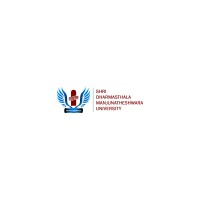 Deadline
Open Deadline
Deadline
Open Deadline
Details of the Organization
Shri Dharmasthala Manjunatheshwara (SDM) Law College, Mangaluru, is a premier institution dedicated to legal education and research. Affiliated with Karnataka State Law University (KSLU), Hubballi, and recognized by the Bar Council of India (BCI), Delhi, the institution is managed by the SDM Educational Society under the leadership of Dr. D. Veerendra Heggade.
Details of the Blog/Paper
The Lex Plus Student Law Review is a peer-reviewed, student-led law journal that aims to encourage academic research in specialized and emerging legal fields. It provides a platform for law students, researchers, and legal professionals to contribute to contemporary legal discussions.
The Editorial Board invites original and unpublished research papers, case commentaries, legislative analyses, and book reviews for Volume V (2024-25) of the journal. Submissions must align with the theme and adhere to the prescribed guidelines.
Topic of paper/Blog
Can Innovation by AI-enabled machines be patented? The Relationship between Intellectual property and Intelligent machines. The Risk of Increasing Intelligent machines with human Innovators. A Special Reference to International Laws Relating to Intelligent Machines and Related Issues.
- They suggest that the research paper should focus on the legal frameworks surrounding the patentability of AI-related inventions with a specific emphasis on comparing how these frameworks operate both internationally and within India.
Media trials and their implications for Real Trials, a review of Ethical Concerns with Media Trials, the need for stricter laws regulating media trials, and a special reference to media law. A bird' s-eye view of international law on Media trials and related issues.
- The writer is expected to analyse the concept of media trials and explore the ethical concerns related to the presumption and fair trial rights. The writer must also compare how media trials are handled in international and Indian legal contexts citing relevant case studies.
Imposing liability of damage caused by a robot, who is liable for Damage caused
by the robots' scientist, robot owner. Can the principle of “respondente superior” be applied here? Need for national laws and international conventions recognising, protecting, and regulating Robots and related issues.
- The writer is expected to explore the challenges of imposing liability for damages caused by robots, focusing on whether the “Doctrine of Respondent Superior” can be applied to robots or not. The writer should examine the current existing legal frameworks and should offer some suggestions.
Role of UN Security Council in mitigating multi-party war. The legal status of veto power, how far the UN fulfilled its objectives. Mass human rights violations during wartime and the role of the UN organisation in mitigating war. Way forward for peaceful coexistence. And related issues.
- The paper should analyse the current limitations and challenges of the UNSC, propose reforms and provide a forward-looking analysis of how the UN can better fulfil its motto.
Can innovation on higher animals be intellectually protected? Recent trends in scientific experiments on human beings and laws. Need for international bodies to overview experimentation on human specimens. Analysis of laws related to human cloning and related issues.
- The paper should contain the intersection of IP and ethical concerns surrounding innovation on higher animals and human experiments. It should also provide insights into existing laws and propose potential reforms.
Is innovation on military equipment protected, issues with military weapons and
the human rights perspective? Allied matter, world view and related issues.
- The paper should focus on the legal framework governing the development and use of emerging military technologies in India. The paper should also examine India’s compliance with international norms and treaties related to military advancements.
Traditional knowledge and intellectual property protection ahead-International
perspective, Related issues
Corporate homicide: how far corporate world responsible and labour law perspective, need for better work-life balance, and allied areas
Regulatory framework for space endeavours. Can prevailing laws hinder Space
tourism? Law related to space explorations and other related issues.
Laws related to air safety in the wake of hoax bomb call treats and way ahead.
Legal rights of political parties towards their Parties symbol, with a special
reference to decided cases.
- The paper should examine the legal right of political parties to use their symbols, focusing on the relevant statutes and decisions of the EC. It should also analyse the case laws concerning the dispute over symbols.
Commercialization of space and the way forward.
- The paper should examine the current developments such as the commercialization of space, the role of private companies and India’s participation in international space treaties. The paper should also include relevant laws and policies related to the ISRO in the sector.
Role of DGCA in regulating the aviation sector. An evolving perceptive in Aviation law
- The paper should provide the relevant laws, policies and regulations relating to the Aviation law in India and the role of the Directorate General of Civil Aviation. The paper can also explore issues like airspace management, passenger rights, liability in accidents and international aviation agreements.
Eligibility
Law students (Undergraduate and Postgraduate).
Types of Submission and Word Limit
- Research Papers (3,000-6,000 words).
- Case Commentaries (1,500-3,000 words).
- Legislative Analysis (2,000-4,000 words).
- Book Reviews (1,000-2,500 words).
Submission Guidelines
Research Papers (3,000-6,000 words).
Case Commentaries (1,500-3,000 words).
Legislative Analysis (2,000-4,000 words).
Book Reviews (1,000-2,500 words).
Formatting Guidelines
File Format: Only Microsoft Word (.doc or .docx) submissions will be accepted. PDF submissions will not be considered.
Main text: Book Antiqua, 14-point font, with 1.5-line spacing.
- Footnotes: Book Antiqua, 10-point font, with single-line spacing.
- Indentation: Each new paragraph must begin with a 1-inch indent.
- Page Layout:
- Margins: 1 inch on all sides.
- Alignment: All text must be left-aligned (justified alignment is not permitted).
Must be numbered and include a clear title.
Citations within tables and figures must follow OSCOLA formatting.
Dates to Remember
Submission Deadline: 20th April 2025.












 ADDICTIVE LEARNING TECHNOLOGY LIMITED
ADDICTIVE LEARNING TECHNOLOGY LIMITED